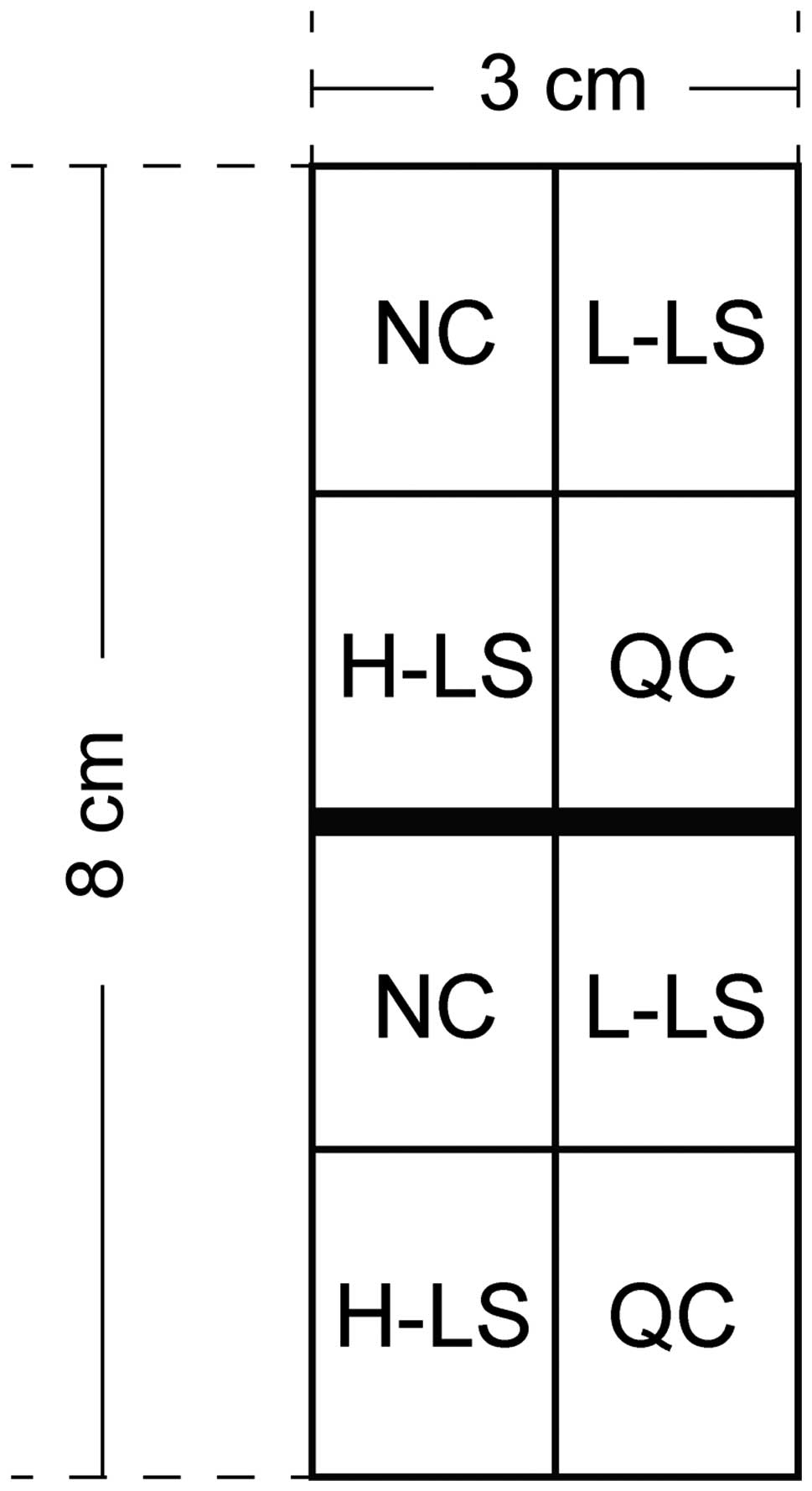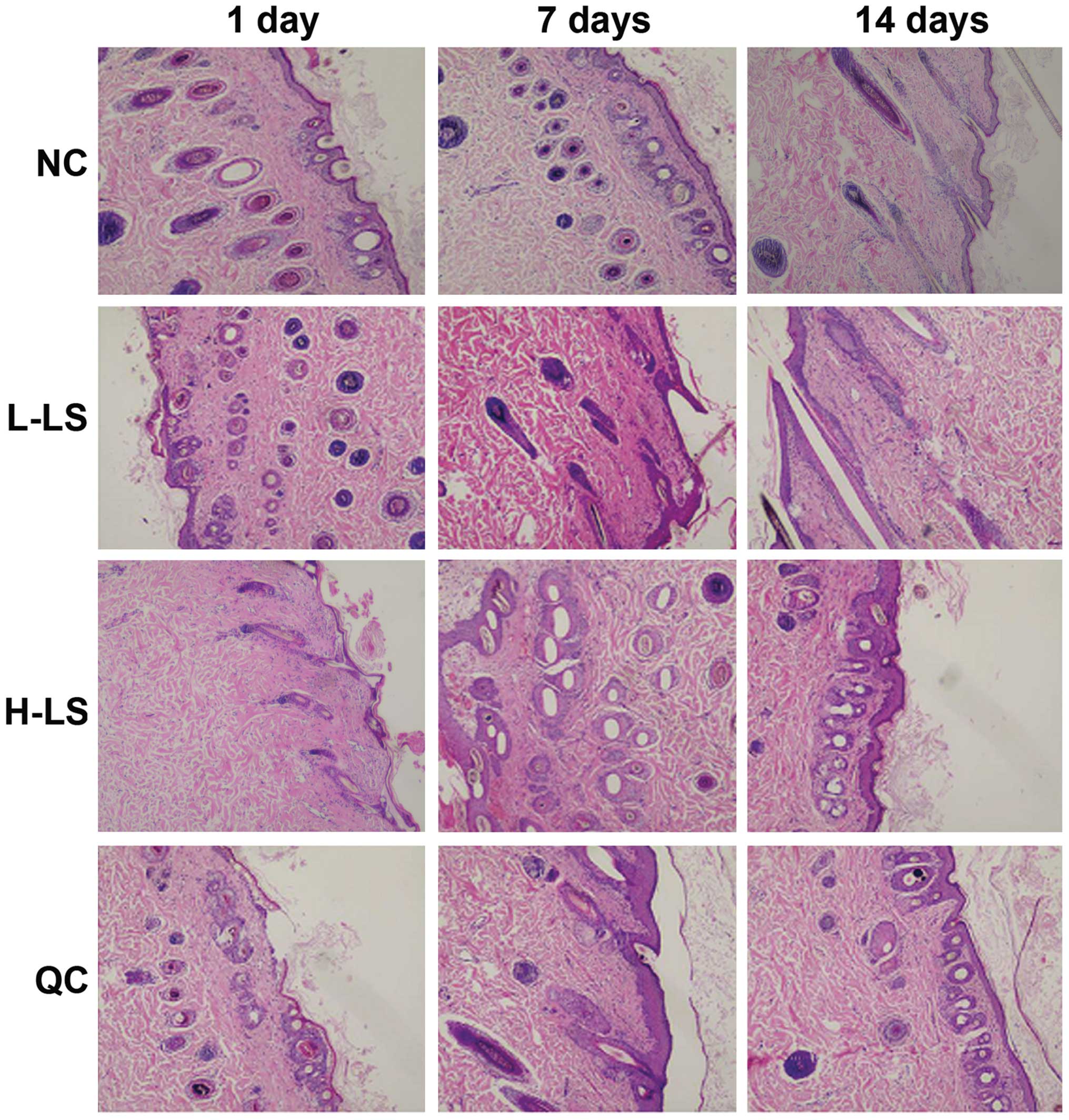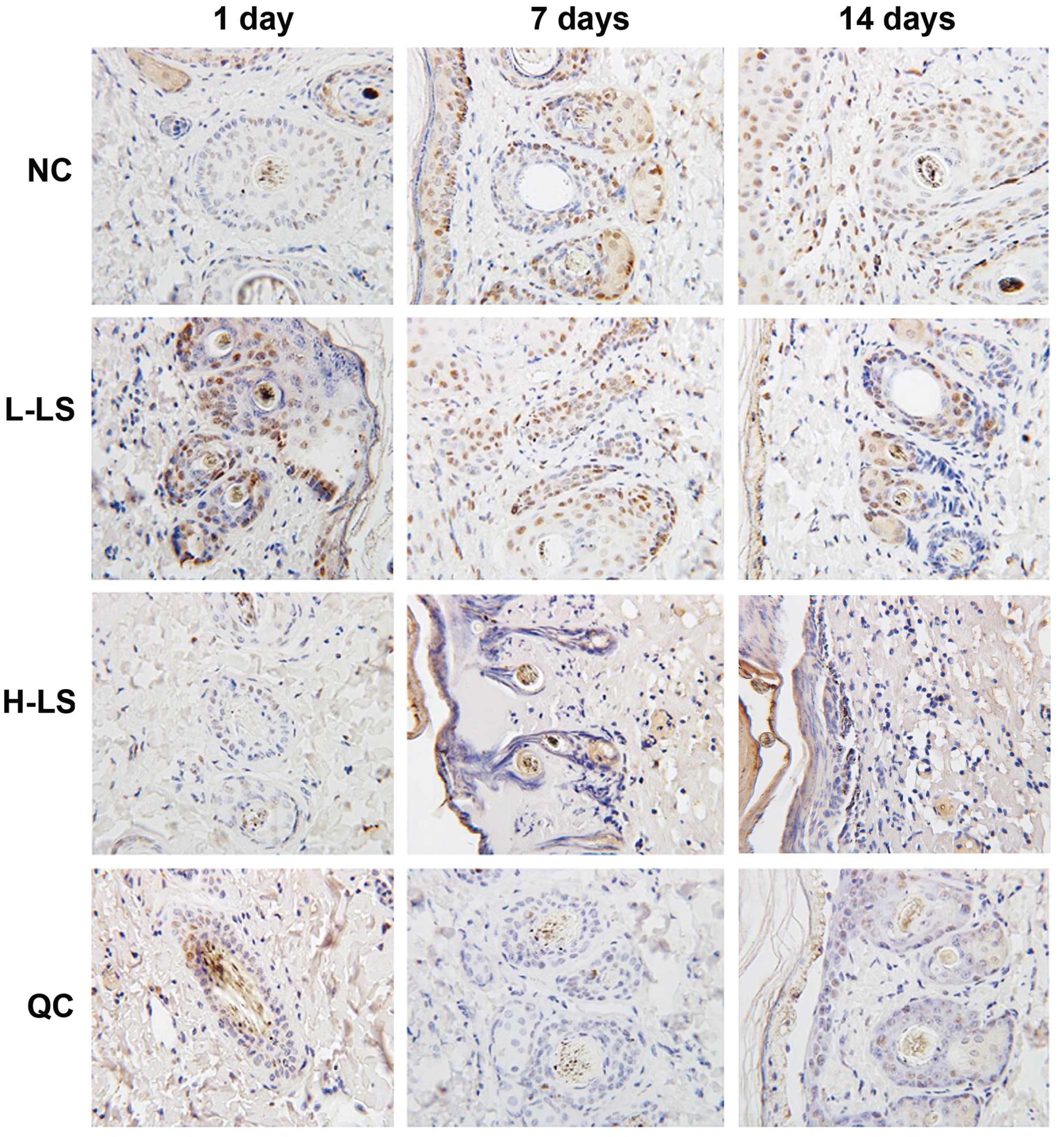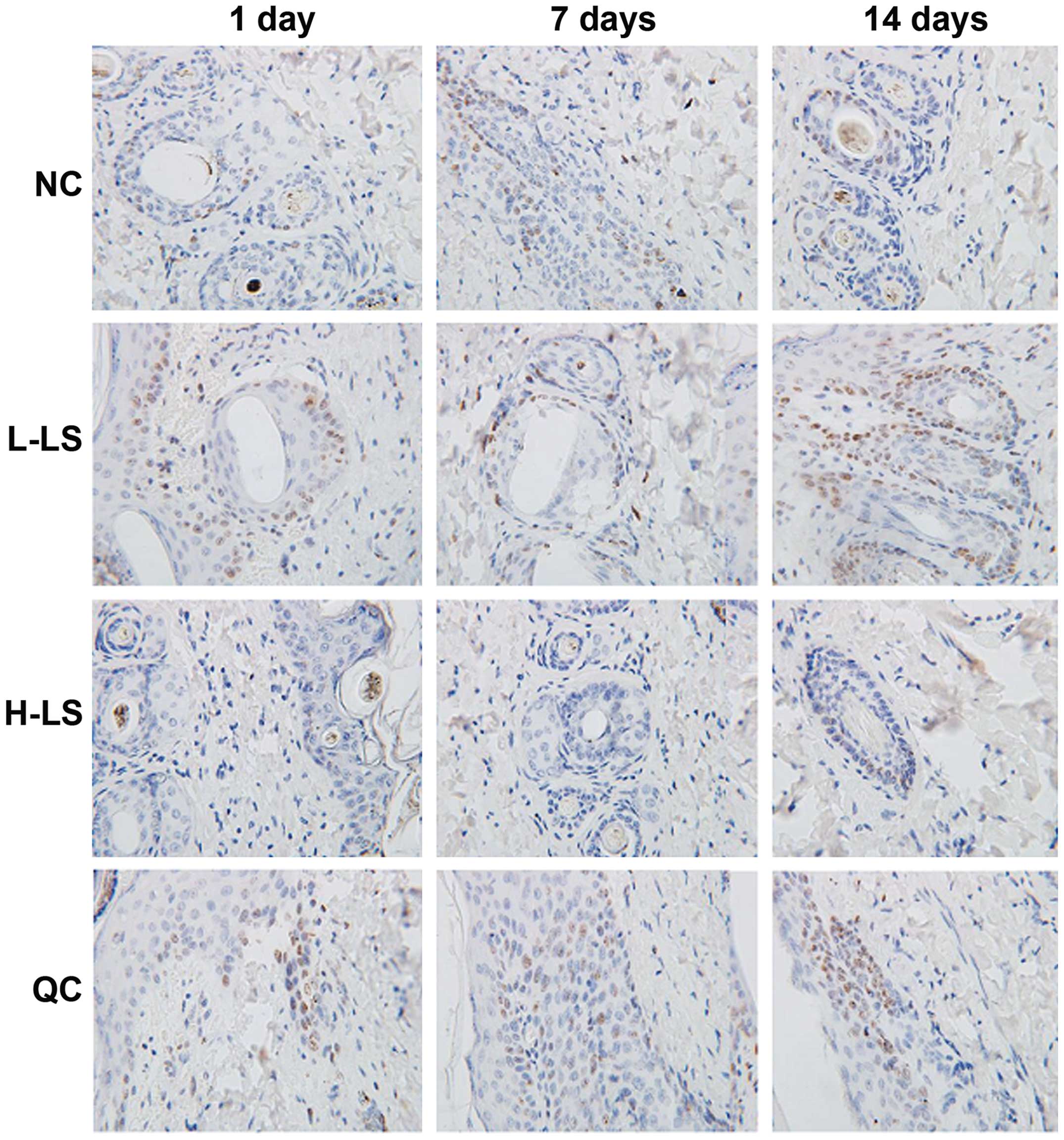Fundamental research on the action mechanism of the 800 nm semiconductor laser on skin blackheads and coarse pores
Retraction in: /10.3892/etm.2024.12709
- Authors:
- Published online on: November 30, 2016 https://doi.org/10.3892/etm.2016.3937
- Pages: 235-241
-
Copyright: © Lin et al. This is an open access article distributed under the terms of Creative Commons Attribution License.
Abstract
Introduction
Blackhead analysis includes blackhead moles, keratosis pilaris, hair follicle ichthyosis, keratosis follicularis and trichostasis spinulosa (1). Pore analysis was divided into three kinds of pore structures: Sweat gland openings that are not visible to the naked eye; hair follicle sebaceous gland openings that are visible to the naked eye; and hair follicle sebaceous gland openings containing keratotic plug that are visible to the naked eye (2). The main reasons for skin blackheads and coarse pores were: Physique, heredity, age, gender, oily skin, hormones affecting skin roughness, collagen density, sebaceous gland distribution and secretion, light aging caused by ultraviolet rays, and poor face-cleaning habits (3). Blackheads and coarse pores can seriously impact facial beauty and reduce the self-confidence of patients (4).
The traditional treatments of acne include needle-lancing and topical drugs, such as retinoic acid and salicylic acid (5). However, conventional cleaning products are ineffective for certain blackheads. Evidence suggests that Q-switched Nd:YAG and lattice laser treatment for blackheads and coarse pores is effective, but the improvement was limited and the effect was not lasting and stable (6).
The aim of the present study was to determine the mechanism of action of the 800 nm semiconductor laser on skin blackheads and coarse pores. To the best of our knowledge, there is no similar experimental study examining this type of laser treatment to treat skin blackheads and coarse pores.
Materials and methods
Experimental animals
A total of 24 healthy purebred short-haired male guinea pigs, weighing 350–400 g, were selected for the present study. The animals were provided by the Shanghai Laboratory Animal Center (Shanghai, China), batch no. SYXK 2015–0016. The guinea pigs were fed routinely in an environment with temperatures of 20–25°C, relative humidity of 55–60%, and light and dark cycle of 12 h each. One week after adapting to the environment, the guinea pigs were coated with 0.5 ml of coal tar suspension (Chongqing Jinrong Chemical Co., Chongqing, China) evenly by injector once daily. Treatment was continued for 14 days to form an experimental area of 8×3 cm on the back of the guinea pigs (Fig. 1).
Experimental groups
The subjects were divided into the following groups: Normal control group (NC); low-dose laser treatment group (L-LS); high-dose laser treatment group (H-LS); and Q-switched Nd:YAG treatment group (QC).
Methods
A LightSheer Duet ET 800 nm semiconductor laser (Lumenis Ltd., Yokneam, Israel) treatment was applied with an energy density of 20–30 J/cm2 (L-LS group), 35–55 J/cm2 (H-LS group) and a Q-switched Nd:YAG mode. Spot testing was completed on an area of molding, with a pulse width of 0.5 msec and a spot size of 7 mm. A single spot was arranged to avoid repetition. During the treatment process, shading pockets were used to cover eyes, with cold compression applied for 30 min after treatment. A Nikon D800 SLR camera (Nikon, Tokyo, Japan) was used to capture images before and after treatments. Samples were taken at 1, 7 and 14 days after surgery. The applications of the experimental method are shown in Fig. 1.
Observation of epidermis, dermis, sebaceous gland changes, and hair follicle damage by hematoxylin and eosin (H&E) staining
A solution of 4% lidocaine was injected locally in the experimental area before skin-tissue cutting, iodine disinfection and oppression hemostasis was performed. A 4% paraformaldehyde fixation was used, along with phosphate-buffered saline (PBS) flushing, gradient alcohol dehydration, xylene transparence, paraffin wax soakage, embedding and a paraffin section device (Beijing Liuyi Instrument Factory, Beijing, China) to cut a 4-µm serial section. This was applied to plaster before drying and performing H&E staining (Thermo Fisher Scientific, Waltham, MA, USA). The sections were observed under a light microscope (Olympus Corp., Tokyo, Japan).
Detection of the expression of proliferating cell nuclear antigen (PCNA) of sebaceous gland cells by immunohistochemical methods
Conventional xylene, gradient alcohol dewaxing, PBS flushing, 50 µl peroxidase, room temperature blocking for 30 min, distilled water washing of 5 min × 3 times, and 0.125% fresh pancreatic enzyme dropping paraffin were all used as part of the testing. A constant temperature box (Sanyo Electric Co., Osaka, Japan) was set at 37°C for incubation for 20 min as 50-µl blocking serum of goat was added and incubated at room temperature for 1 h. Rabbit anti-PCNA monoclonal antibody (no. sc-7907) at a concentration of 1:2,000) and internal resistance rabbit anti-GAPDH monoclonal antibody (no. sc-25778) (both from Santa Cruz Biotechnology, Inc., Dallas, TX, USA) at a concentration of 1:1,000 and incubated at 4°C overnight. PBS cleaning 5 min × 3 times; 50 BB rat anti-rabbit bivalent antibody (Beijing Zhongshan Golden Bridge Biotechnology Co., Ltd., Beijing, China) at a concentration of 1:500 was added. Biotin labeling was incubated at room temperature for 1 h with PBS rinsing for 5 min × 3 times, while 50 µl horseradish peroxidase (Beijing Zhongshan Golden Bridge Biotechnology Co., Ltd.) was added and incubated at room temperature for 1 h with PBS cleaning for 5 min × 3 times. The samples were kept in the dark as 20 µl chromogenic solution (Beijing Zhongshan Golden Bridge Biotechnology Co., Ltd.) at a concentration of 1:50 was added. Hematoxylin redyeing, ethyl alcohol differentiation, gradient dehydration, xylene lucency and neutral gum seal sheets were utilized. The results were observed by a low-power lens.
Test sebaceous gland cell apoptosis using TUNEL
Under the condition of conventional dewaxing and rehydration, 20 mg/ml proteinase K (Chongqing Bofei Biochemical Products Co., Ltd., Chongqing, China) without DNase was incubated at 37°C for 20 min with PBS washing 5 min × 3 times. Hydrogen peroxide of 3% was placed at room temperature for 10 min with PBS washing 5 min × 3 times. TUNEL reaction mixture (Hoffmann-La Roche, Basel, Switzerland) was prepared and added to create a 50 cr TUNEL reaction mixture, followed by adjusting the thermostat to 37°C, and wet box reacting for 60 min with PBS washing 5 min × 3 times. POD transforming agent (50 µl) was added and incubated at 37°C in a wet box for 30 min with PBS washing for 5 min × 3 times. Hematoxylin redyeing, ethyl alcohol differentiation, gradient dehydration, xylene lucency and neutral gum seal sheet were utilized. The results were observed by a low-power lens.
Detection of protein expression of caspase-3, Bax and Bcl-2 by western blot analysis
For cell total protein extraction, cell lysis liquid P0013 (Beyotime Institute of Biotechnology, Jiangsu, China) at a final concentration of 1 mM was used and blended thoroughly. It was placed on ice and centrifuged at 10,000 for 20 min. The supernatant was the extraction of the total protein. For the protein concentration determination, a BCA protein concentration determination kit P0009 (enhancement mode) (Beyotime Institute of Biotechnology) was used to detect protein according to the manufacturer's instructions. For the protein sample handling, we used protein electrophoresis to calculate the volume. A corresponding 5X loading buffer with a final concentration of 1X loading buffer was added, and blending, heating, centrifugation and electrophoresiswere conducted. We utilized sodium dodecyl sulphate-polyacrylamide gel electrophoresis (SDS-PAGE), transmembrane protein (wet), sealing and the incubation of the primary antibodies. To determine a pre-staining protein molecular mark, a PVDF membrane was cut according to a target protein molecular weight. This was placed in the antibody incubation box with the following: A 1X TBST washing, rabbit anti-caspase-3 monoclonal antibody, no. sc-98785 at a concentration of 1:2,000, and a rabbit anti-Bax monoclonal antibody, no. sc-25778 (both from Santa Cruz Biotechnology, Inc.) at a concentration of 1:1,000. Incubation of secondary antibody (the primary antibody was recycled with 1X TBST washing before 5 ml of skim milk at a 5% concentration and a corresponding species secondary antibody was added according to the proportion of 1:5,000–1:20,000), and exposed (chemiluminescence methI). The results were expressed by the gray value ratio of the band.
Statistical analysis
SPSS 20.0 software (IBM, Armonk, NY, USA) was used for statistical analysis. Measurement data were presented as mean ± standard deviation. Comparison between groups was performed using one-way ANOVA test followed by post hoc test (LSD). The comparison in one group introduced variance analysis to repeat measurement data. P<0.05 was considered to indicate a statistically significant difference.
Results
H&E staining results
Two to four cell layers of hair follicle epithelium were evident in the NC group. Its follicular infundibulum did not expand, while the hair follicle appeared quasicircular. The mesenchyme did not have infiltration of inflammatory cells. In the L-LS group, we observed hair follicle distortion and abundant infiltration of inflammatory cells at 1 day. Hair follicle retrogression and the separation between papilla and hair bulb were seen at 7 days. At 14 days, the hair follicle epithelium appeared thin, inflammatory cells were reduced and the hair follicle form returned to normal. In the H-LS group, abundant inflammatory necrosis under the hair follicle was visible, with the hair shaft being heated for 7 days. This reduced hair follicle amounts at 14 days. In the QC group, the infiltration of inflammatory cells was seen at 1 day, with hair follicle deformation at 7 days and partial hair follicle inflammatory necrosis at 14 days (Fig. 2).
Immunohistochemistry
The expression levels of PCNA of the L-LS, H-LS and QC groups were reduced with time. At the respective time points, the NC group was highest, L-LS group and H-LS group were next highest and the H-LSIup was lowest. The difference was statistically significant (P<0.05) (Table I and Fig. 3).
TUNEL method result
The apoptotic rate of the L-LS, H-LS and QC groups increased with time extension. At the different time points, NC group was lowest, the L-LS group and QC group was next and the H-LS group was highest, with the difference being statistically significant (P<0.05) (Table II and Fig. 4).
Western blot analysis
The protein expression level of caspase-3, Bax and Bcl-2 of the L-LS, H-LS and QC groups increased with time. At the respective time points, caspase-3 and Bax protein expression in the NC group was lowest, the L-LS and QC groups were next lowest and the H-LS group was highest. Bcl-2 protein expression in the NC group was highest, the protein expression in the NC group was next highest and the H-LS group was lowest. The difference was statistically significant (P<0.05) (Table III and Fig. 5).
Discussion
The 800 nm semiconductor laser can be used in the treatment of vascular diseases, such as nevus flammeus, and for non-vascular diseases, such as virus infection, sebaceous gland hyperplasia and stretch marks (7,8). Evidence has confirmed that it has an effect on immunity activation, acne formation reduction and hair follicle wall maturity intervention (9). The semiconductor laser takes advantage of many types of biological effects on skin hair follicle tissue, such as thermal effects, pressure effects, photochemical effects, light stimulation and electromagnetic fields, leading to the release of cytokines and the production of collagen (10). From animal models, it has been found that semiconductor lasers can significantly reduce the number of facial acne propionic acid bacillus, with grease secretion decreasing significantly. Additionally, the cytokines IL-1α receptor, TNF-α, melanocortin receptor 1 and TGF-β1 can be reduced in tissues, so as to achieve the effect of treating diseases (11).
A recent study also confirmed that semiconductor lasers can induce the apoptosis of the hair follicles, which may be associated with the therapeutic effect of the lasers (12). PCNA is the core element of the eukaryotes replication complex, a driving factor in DNA polymerase δ, which can bind with different replication-associated proteins and coordinate the DNA replication process (13). As a factor of function conversion, PCNA is involved in important cell events, such as DNA damage repair, cell cycle control and apoptosis by different control methods to interact with many cytokines (14). It is known that apoptosis may have three main signal transduction pathways: Death receptor pathways of apoptosis, mitochondrial pathways, and control pathways on which the p53 gene depends. The p53 gene is a type of tumor-inhibiting protein that is expressed by the control-associated gene to induce apoptosis (15). The tumor-inhibiting factor in G1 contains the PIP box, which can promote apoptosis by interacting with p53. Experimental results showed that ultraviolet rays can promote the combination of ING1 and PCNA, and that ultraviolet ray damage cell may be removed by apoptosis (15). Caspase-3 is a factor in performing apoptosis, which can cause a cascade amplification effect of downstream enzymes once triggered. Its excitation can lead apoptosis to an apoptosis stage that is related to nuclear change and is the most important downstream effect of protease (16). For the two signal transduction pathways of conventional evolution in apoptosis, the component ratio of Bcl-2 family members is the key factor of apoptosis regulation, especially the Bcl-2/Bax ratio in the ‘molecular switch’ that can trigger apoptosis (17). Bax and Bcl-2 regulate apoptosis by forming homodimer or heterodimer, when Bax forms homodimer to induce apoptosis, Bax and Bcl-2 may form a heterodimer to inhibit apoptosis.
From the present study, we found that the expression levels of PCNA of the L-LS, H-LS and QC groups reduced with time. At the respective time points, the NC group was highest, the L-LS and H-LS groups were next highest and the H-LS group was lowest. The difference was statistically significant (P<0.05). It suggested that low-dose laser treatment causes less damage to the number of PCNA, which is beneficial in the recovery of hair follicle regeneration capacity (18). The apoptotic rate of the L-LS, H-LS and QC groups increased with time. At the respective time points, the NC group was lowest, the L-LS and QC groups were next lowest and the H-LS group was highest. The difference was statistically significant (P<0.05). It suggested that low-dose laser treatment can promote the apoptosis of hair follicle cells to some extent (19). The protein expression of caspase-3, Bax and Bcl-2 in the L-LS, H-LS and QC groups increased with time. At the respective time points, caspase-3 and Bax protein expression in the NC group was lowest, the L-LS and QC groups were next lowest and the H-LS group was highest. Bcl-2 protein expression in the NC group was highest, protein expression in the NC group was in next highest and the H-LS group was lowest. The difference was statistically significant (P<0.05).
In conclusion, the low-dose 800 nm semiconductor laser is an effective treatment on skin blackheads and coarse pores. It promotes hair follicle cell apoptosis without reducing the expression of PCNA.
References
|
Ashique KT and Srinivas CR: Pen punching: an innovative technique for comedone extraction from the well of the concha. J Am Acad Dermatol. 73:e1772015. View Article : Google Scholar : PubMed/NCBI | |
|
Handler MZ, Bloom BS and Goldberg DJ: Energy-based devices in treatment of acne vulgaris. Dermatol Surg. 42:573–585. 2016. View Article : Google Scholar : PubMed/NCBI | |
|
Keyal U, Bhatta AK and Wang XL: Photodynamic therapy for the treatment of different severity of acne: a systematic review. Photodiagn Photodyn Ther. 14:191–199. 2016. View Article : Google Scholar | |
|
Demirci GT, Mansur AT and Gulec AT: Comedones induced by vascular laser therapy. J Cutan Aesthet Surg. 9:38–40. 2016. View Article : Google Scholar : PubMed/NCBI | |
|
Lee SJ, Seok J, Jeong SY, Park KY, Li K and Seo SJ: Facial pores: definition, causes, and treatment options. Dermatol Surg. 42:277–285. 2016. View Article : Google Scholar : PubMed/NCBI | |
|
Levin MK, Ng E, Bae YS, Brauer JA and Geronemus RG: Treatment of pigmentary disorders in patients with skin of color with a novel 755 nm picosecond, Q-switched ruby, and Q-switched Nd:YAG nanosecond lasers: a retrospective photographic review. Lasers Surg Med. 48:181–187. 2016. View Article : Google Scholar : PubMed/NCBI | |
|
Lapchak PA, Boitano PD, Butte PV, Fisher DJ, Hölscher T, Ley EJ, Nuño M, Voie AH and Rajput PS: Transcranial near-infrared laser transmission (NILT) profiles (800 nm): systematic comparison in four common research species. PLoS One. 10:e01275802015. View Article : Google Scholar : PubMed/NCBI | |
|
Lekakh O, Mahoney AM, Novice K, Kamalpour J, Sadeghian A, Mondo D, Kalnicky C, Guo R, Peterson A and Tung R: Treatment of acne vulgaris with salicylic acid chemical peel and pulsed dye laser: a split face, rater-blinded, randomized controlled trial. J Lasers Med Sci. 6:167–170. 2015. View Article : Google Scholar : PubMed/NCBI | |
|
Morton LM: The evolution of laser surgery for acne and other scarring processes. Semin Cutan Med Surg. 33:169–175. 2014. View Article : Google Scholar : PubMed/NCBI | |
|
Been MJ and Mangat DS: Laser and face peel procedures in non-Caucasians. Facial Plast Surg Clin North Am. 22:447–452. 2014. View Article : Google Scholar : PubMed/NCBI | |
|
Avci P, Gupta A, Sadasivam M, Vecchio D, Pam Z, Pam N and Hamblin MR: Low-level laser (light) therapy (LLLT) in skin: stimulating, healing, restoring. Semin Cutan Med Surg. 32:41–52. 2013.PubMed/NCBI | |
|
da Silva Neto Trajano L Alexsandra, da Silva CL, de Carvalho SN, Cortez E, Mencalha AL, de Souza da Fonseca A and Stumbo AC: Cell viability, reactive oxygen species, apoptosis, and necrosis in myoblast cultures exposed to low-level infrared laser. Lasers Med Sci. 31:841–848. 2016. View Article : Google Scholar : PubMed/NCBI | |
|
Khalil MI, Ibrahim MM, El-Gaaly GA and Sultan AS: Trigonella foenum (fenugreek) induced apoptosis in hepatocellular carcinoma cell line, HepG2, mediated by upregulation of p53 and proliferating cell nuclear antigen. Biomed Res Int. 2015.914645PubMed/NCBI | |
|
Melo RM, Martins YS, Luz RK, Rizzo E and Bazzoli N: PCNA and apoptosis during post-spawning ovarian remodeling in the teleost Oreochromis niloticus. Tissue Cell. 47:541–549. 2015. View Article : Google Scholar : PubMed/NCBI | |
|
Li DW, Li GR, Zhang BL, Feng JJ and Zhao H: Damage to dopaminergic neurons is mediated by proliferating cell nuclear antigen through the p53 pathway under conditions of oxidative stress in a cell model of Parkinson's disease. Int J Mol Med. 37:429–435. 2016.PubMed/NCBI | |
|
Lossi L, Cocito C, Alasia S and Merighi A: Ex vivo imaging of active caspase 3 by a FRET-based molecular probe demonstrates the cellular dynamics and localization of the protease in cerebellar granule cells and its regulation by the apoptosis-inhibiting protein survivin. Mol Neurodegener. 11:342016. View Article : Google Scholar : PubMed/NCBI | |
|
Duan P, Hu C, Butler HJ, Quan C, Chen W, Huang W, Tang S, Zhou W, Yuan M, Shi Y, et al: 4-Nonylphenol induces disruption of spermatogenesis associated with oxidative stress-related apoptosis by targeting p53-Bcl-2/Bax-Fas/FasL signaling. Environ Toxicol. 18:14–15. 2016. | |
|
Tsai WC, Cheng JW, Chen JL, Chen CY, Chang HN, Liao YH, Lin MS and Pang JH: Low-level laser irradiation stimulates tenocyte proliferation in association with increased NO synthesis and upregulation of PCNA and cyclins. Lasers Med Sci. 29:1377–1384. 2014. View Article : Google Scholar : PubMed/NCBI | |
|
Mun S, Cheon M, Kim SH, Choi N, Kim S, Yoo Y and Lim S: The effect of laser diode irradiation on wound healing of rat skin. J Cosmet Laser Ther. 15:318–325. 2013. View Article : Google Scholar : PubMed/NCBI |














